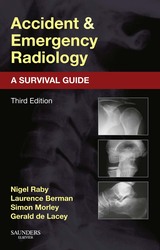「重要なお知らせ:日本語書籍をご購入いただき、eLibraryをご利用の皆さまへ」
エルゼビアは、より快適にサービスをご利用いただくため、システムの重要なアップデートを実施いたします。
現在、新サイト、eBooks+への移行が進められています。
新規ユーザー登録および書籍の登録はElsevier eLibraryでは停止しております。
12月15日以降に
こちらよりご利用・ご登録ください。
Book Description
Since it was first published, Accident and Emergency Radiology: A Survival Guide has become the classic reference and an indispensable aid to all those who work in the Emergency Department. The core and substantial value lies in the step-by-step analytical approaches which help you to answer this question: "These images look normal to me, but . . . how can I be sure that I am not missing a subtle but important abnormality?"
- Consult this title on your favorite e-reader, conduct rapid searches, and adjust font sizes for optimal readability.
- Ensure accuracy in reading and interpretation of any given image. Common sources of error and diagnostic difficulty are highlighted.
- Prevent mistakes. Pitfalls and associated abnormalities are emphasized throughout.
- Avoid misdiagnoses. Normal anatomy is outlined alongside schemes for detecting variants of the norm. Each chapter concludes with a summary of key points. Will provide a useful overview of the most important features in diagnosis and interpretation.
- Easily grasp difficult anatomical concepts. Radiographs accompanied by clear, explanatory line-drawings.
- Spend less time searching with an improved layout and design with succinct, easy-to-follow text. A templated chapter approach helps you access key information quickly. Each chapter includes key points summary, basic radiographs, normal anatomy, guidance on analyzing the radiographs, common injuries, rare but important injuries, pitfalls, regularly overlooked injuries, examples, and references.
- Grasp the nuances of key diagnostic details. Updated and expanded information, new radiographs, and new explanatory line drawings reinforce the book’s aim of providing clear, practical advice in diagnosis.
- Avoid pitfalls in the detection of abnormalities that are most commonly overlooked or misinterpreted.


 (0 rating)
(0 rating) 





